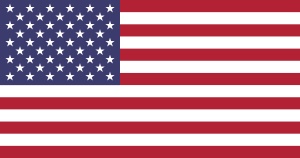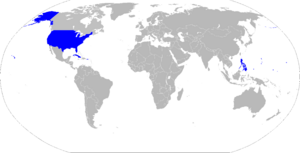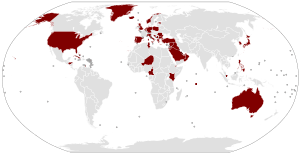American Century facts for kids
The American Century is a way to describe the time since the middle of the 1900s. During this period, the United States has been very powerful in politics, money, and culture around the world. It's similar to how the years 1815–1914 were called Britain's Imperial Century.
The United States' power grew a lot during the 20th century. It became especially strong after World War II ended. At that time, only two major world powers, called superpowers, were left: the United States and the Soviet Union. After the Soviet Union broke apart in 1991, the United States was the only superpower left. Some people then called it a hyperpower, meaning it was extremely powerful.
Contents
What Does "American Century" Mean?
How the Phrase Was First Used
The phrase "American Century" was created by Henry Luce, who was the publisher of Time magazine. He used it to explain what he thought the United States' role in the world should be during the 20th century.
In 1941, Luce wrote an article in Life magazine. He urged the United States to stop being isolated from the world. Instead, he believed the U.S. should act like a "Good Samaritan" and help spread democracy around the globe. He wanted the U.S. to join World War II to protect democratic values.
Luce believed that American ideas like freedom would "lift the life of mankind." He thought the world could only become strong and healthy under an "American Century."
Global Influence, Not Just Land
According to a scholar named David Harvey, Luce saw America's power as global, not just about owning land. That's why he talked about an "American Century" instead of an "empire." Luce also said that the United States should use its full influence in the world for whatever purposes it thought were right.
Early Steps Towards Global Power
America's Growing Role in the World
Towards the end of the 1800s, the United States started to play a bigger role outside North America. This began with events like the Spanish–American War in 1898 and the Boxer Rebellion in China. The U.S. government started to protect its own industries and built a strong navy, known as the "Great White Fleet."
When Theodore Roosevelt became president in 1901, he sped up this change. The U.S. moved away from being isolated and became more involved in other countries' affairs. This process had started under the previous president, William McKinley.
Expanding Influence in the Americas
For example, the United States fought the Philippine–American War to control the Philippines, which it had recently gained. In 1904, President Roosevelt decided the U.S. would build the Panama Canal. This created the Panama Canal Zone, which was controlled by the U.S.
Roosevelt also introduced the Roosevelt Corollary to the Monroe Doctrine in 1904. This policy said that the United States had the right to step in anywhere in the Americas. This showed that the U.S. was becoming the main power in its region.
World War I and a Return to Isolation
When World War I started in 1914, the United States tried to stay out of the conflict. President Woodrow Wilson later argued that the war was so important that the U.S. needed to be part of the peace talks. The United States was not officially part of the Allies but joined the war in 1917 as an "Associated Power."
At first, the U.S. army was small. However, after the Selective Service Act of 1917 was passed, 2.8 million men were drafted. By summer 1918, the U.S. was sending 10,000 new soldiers to France every day. The war ended in 1919 with the Treaty of Versailles. After the war, the United States went back to being isolated. It refused to approve the Treaty of Versailles or join the League of Nations.
Between the World Wars
During the years between World War I and World War II, the U.S. focused on protecting its own economy. This was especially true after the Smoot–Hawley Tariff Act, which many economists believe made the Great Depression worse around the world. However, starting in 1934, the U.S. began to open up trade through the Reciprocal Trade Agreements Act.
When World War II began in 1939, the U.S. Congress eased some of the Neutrality Acts of the 1930s. But the U.S. still did not want to join the war in Europe. In 1940, the United States was only the 18th strongest military power. Even though U.S. destroyers were fighting at sea as part of the Neutrality Patrol, Congress had not declared war. Most Americans still wanted to stay out of the conflict. The America First Committee, with 800,000 members, strongly opposed any U.S. involvement in the European war. However, the U.S. did sell military aid to the United Kingdom and the Soviet Union through the Lend-Lease program.
Joining World War II
In his 1941 State of the Union address, known as the Four Freedoms speech, President Franklin D. Roosevelt changed the country's policy of non-interventionism. He explained that the U.S. would help its allies who were already fighting. By August, President Roosevelt and British Prime Minister Winston Churchill had written the Atlantic Charter. This document set goals for the world after the war.
In December 1941, Japan attacked American and British territories. These attacks in Southeast Asia and the Central Pacific included an attack on Pearl Harbor in Hawaii. These attacks led the United States and United Kingdom to declare war on Japan. Three days later, Germany and Italy declared war on the United States, and the U.S. declared war back on them.
During the war, the Big Four powers (the United States, United Kingdom, the Soviet Union, and China) met to plan the post-war world. To keep peace, the Allies created the United Nations. It officially started on October 24, 1945. In 1948, the United Nations adopted the Universal Declaration of Human Rights, which set common standards for all member countries. The United States also worked closely with the United Kingdom to create the IMF, World Bank, and NATO.
Pax Americana: An Era of Peace
Pax Americana is a term that describes the period of relative peace in the Western world. This peace largely came about because of the great power held by the United States of America starting in the mid-20th century. While the term is mostly used for the late 1900s, it has been used at other times too. Its modern meaning refers to the peace that began after World War II ended in 1945.
The American Century After 1945
The American Century continued through the Cold War. During this time, the United States was clearly the most powerful of the world's two superpowers. After the Cold War ended, most people believed that only the United States met the requirements to be called a superpower.
Size and Population
The United States is the fourth-largest country in the world by land area, covering about 9.37 million square kilometers. In 1990, its population was 248.7 million, making it the fourth-largest nation at that time.
Political and Economic Strength
In the mid-to-late 20th century, the U.S. was a strong capitalist country with a federal government and a constitution. It had a permanent seat on the United Nations Security Council, along with two allies who also had permanent seats: the United Kingdom and France. The U.S. had strong connections with capitalist countries in Western Europe, Latin America, the British Commonwealth, and several East Asian countries like Korea, Taiwan, and Japan. It formed alliances with both right-wing dictatorships and capitalist democracies.
The American Century also includes the strong economic influence of the United States. Many countries around the world adopted the economic policies known as the Washington Consensus during the 20th century. The U.S. economy was very powerful at the end of the century, being by far the largest economy in the world. The U.S. had many natural resources, a large and modern farming industry, and a big industrial base. The United States dollar became the main world reserve currency under the Bretton Woods system. U.S. economic ideas were based on capitalism, where production is guided by what customers want. America was allied with the G7 major economies. The U.S. also promoted its economic policies as the "standard" way to help developing countries facing crises. These policies were supported by international groups like the International Monetary Fund (IMF), World Bank, and the U.S. Treasury Department.
Military Power and Cultural Impact
The military of the United States was a very advanced, naval-based force. It had by far the highest military spending in the world. The United States Navy was the largest navy globally, with the most aircraft carriers. It had military bases all over the world, especially in a ring around the Warsaw Pact states. During the first half of the Cold War, the U.S. had the largest nuclear arsenal in the world. It also had one of the largest armies and one of the two largest air forces. Its strong military allies in Western Europe (the North Atlantic Treaty Organisation) also had their own nuclear weapons. The U.S. also had a powerful global intelligence network through the Central Intelligence Agency.
The cultural influence of the U.S., often called Americanization, can be seen in how U.S. music, TV shows, films, art, and fashion spread to other countries. People also admired the freedom of speech and other rights enjoyed by Americans. U.S. pop stars like Elvis Presley, Michael Jackson, and Madonna became famous worldwide.
Looking at the American Century
Different Views and Criticisms
Some people have criticized Henry Luce's strong belief in America's role, calling it "jingoistic" (meaning overly patriotic and aggressive). Others have talked about the end of the 20th century and the American Century. For example, the journalist Hunter S. Thompson titled his 2003 autobiography Kingdom of Fear: Loathsome Secrets of a Star Crossed Child in the Last Days of the American Century.
As the new millennium began, some experts from the University of Illinois debated whether America was losing its superpower status, especially with China's rise. Other experts have suggested that the "American Century" fits perfectly between America's late entry into World War I in 1917 and the start of its 45th President's term in 2017.
However, some scholars, like George Friedman, believe that the 21st century will also be an American century.
|
See also
 In Spanish: Siglo estadounidense para niños
In Spanish: Siglo estadounidense para niños




